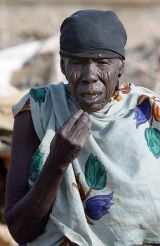North and West Darfur extremely food insecure
NAIROBI, Jan 20, 2005 (IRIN) — The food security situation in the western Sudanese region of Darfur and certain parts of southern Sudan remains a matter of concern, the USAID-funded Famine Early Warning Systems Network (FEWS Net) has warned.
 While calling the situation in North and West Darfur “extremely food insecure”, FEWS Net in their Greater Horn of Africa Food Security Bulletin for January 2005, said conflicts and civil insecurity were likely to continue to imperil the food security of populations in the region.
While calling the situation in North and West Darfur “extremely food insecure”, FEWS Net in their Greater Horn of Africa Food Security Bulletin for January 2005, said conflicts and civil insecurity were likely to continue to imperil the food security of populations in the region.
Peter Smerdon, senior spokesperson of the World Food Programme (WFP), confirmed to IRIN on Wednesday that “hostilities continue to hamper WFP food distribution in Darfur,” while the need for food assistance remained great.
In spite of the continuing insecurity and the resulting logistical delays, however, WFP food distributions reached the highest level so far. In December, 23,600 mt of food were distributed to 1.5 million people in Darfur, he said.
An ICRC assessment team, which had evaluated the food security situation in 20 rural villages in September, reported that agriculture had collapsed and a combination of insecurity and drought had destroyed traditional coping mechanisms of communities in Darfur. In many cases, farmers’ seeds and tools had been looted and their cattle stolen.
A comprehensive nutrition and food security assessment, released by WFP on 26 October, estimated that almost 22 percent of children under the age of five were malnourished, and close to half of all families did not have enough food.
Meanwhile, in southern Sudan, hope for stability has increased following the peace agreement between the Government of Sudan and the Sudan People’s Liberation Movement/Army (SPLM/A). The FEWS Net report anticipated that this would allow more people to settle and manage their livelihoods without disruption.
However, as the 2004 crop harvest in most of southern Sudan was worse than the 2003 harvest, households were rapidly depleting their food stocks and increased food insecurity was expected in February.
The FEWS NET report also expected that the successful peace agreement would increase population movements, especially the return of previously displaced people. Since the returnees would not have been able to produce their own food, they would need relief assistance.
For households in southern Sudan, the level of food insecurity could be compounded by a shortage of supplementary sources of food, particularly fish and wild lily, if the water levels from Lake Victoria and stream catchments, currently below normal, do not improve.
However, the International Research Institute for Climate Prediction, based in New York, has forecast a 75 percent probability for an increased likelihood of normal to above normal rainfall in East Africa that could extend into the normally dry months of January and February.
As a result, water levels on Lake Victoria are expected to rise and flooding waters could benefit areas in southern Sudan, increasing the availability of fish and water lily in the Nile basin areas of southern Sudan.
